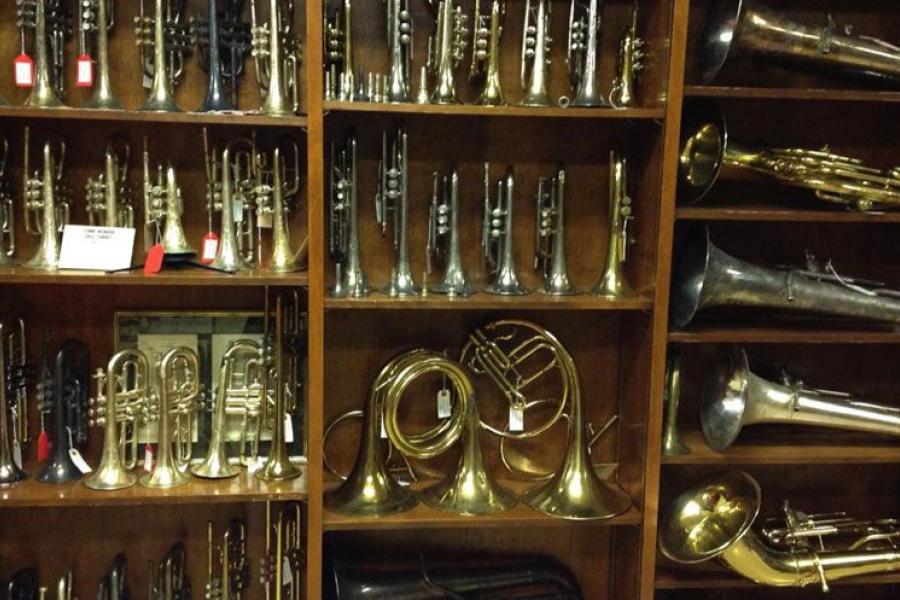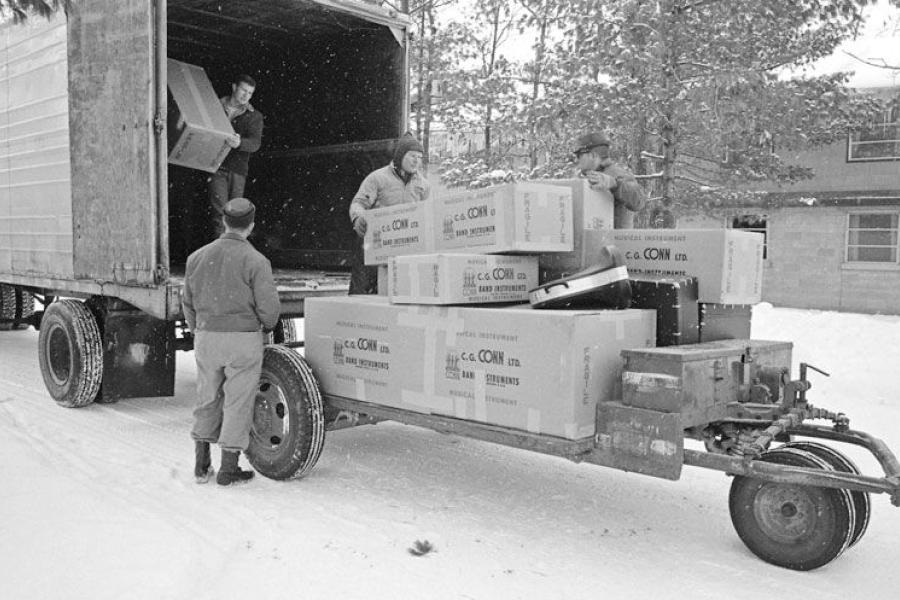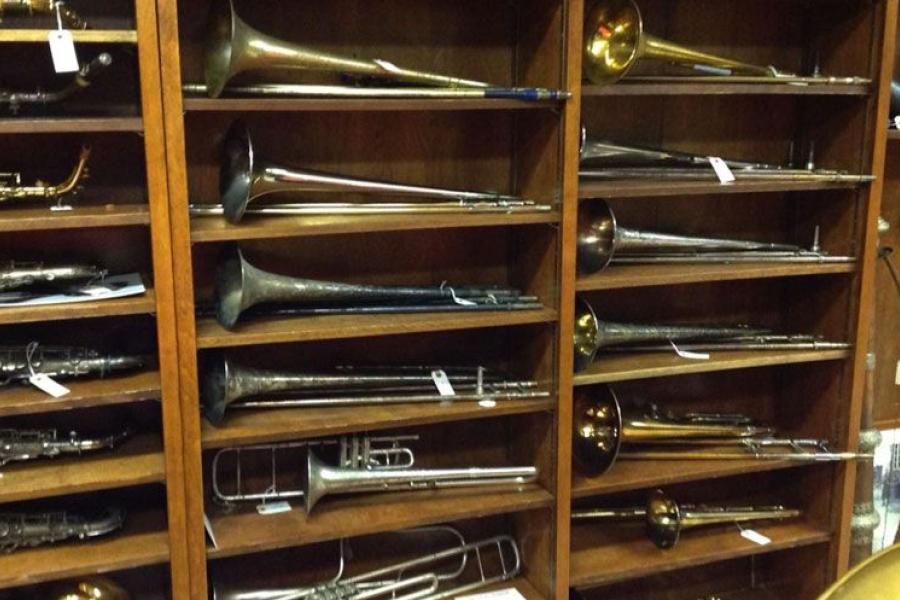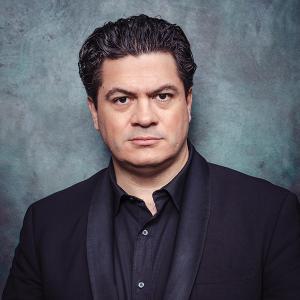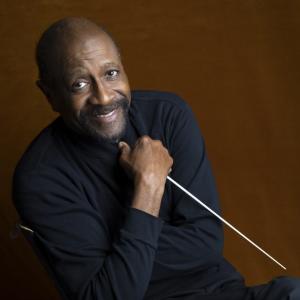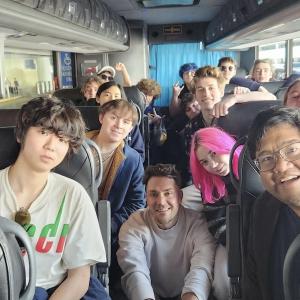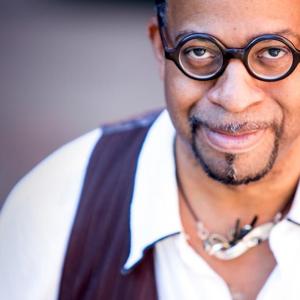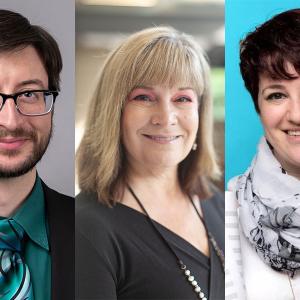Interlochen Online's next session begins May 6—enroll in any course or certificate program now.
Exploring the archives: A golden anniversary for an Interlochen treasure
The Greenleaf Collection’s rich history with Interlochen Center for the Arts continues to shine throughout campus.
Exploration is the mother of discovery. In upcoming episodes of Crescendo, we will explore the extensive holdings of the Archives of the Interlochen Center for the Arts (ARTICA) and relate some of the discoveries made therein. These discoveries are of two kinds: the expected and the unexpected. The former requires thorough research; the latter requires as much and something more—the intervention of chance.
As 2019 comes to a close, we celebrate the 50th anniversary of a key part of the archives—the Leland B. Greenleaf Musical Instrument Collection. Donated to Interlochen in December of 1969, ‘the Greenleaf’ as it is affectionately known, constitutes one of the most fascinating donations ever received by our institution. Arriving on campus on the last day of the 1960s, the collection consists of nearly 300 musical instruments, primarily brass and woodwinds, along with numerous ethnographic instruments from various world cultures. How it came to be, and how it came here, is a tale of corporate history, research, and philanthropy, as well as the intertwined destinies of our institution and the world’s largest instrument maker.
Joe Maddy's angel
In 1928, Joe Maddy and Thaddeus Giddings founded the National High School Orchestra Camp here at Interlochen. In order to make that dream a reality, they needed working capital, and their ‘angel’ appeared in the person of Carl D. Greenleaf, the president of the Conn instrument company. Greenleaf had purchased the company from its founder, Col. C. G. Conn, in 1915, and solidified its stature as the world’s largest manufacturer of brass and woodwind instruments. Having previously funded the 1922 publication of The Universal Teacher, a music instruction booklet by Maddy and Giddings, Greenleaf was approached by them for financial support for the nascent music camp. He responded with a combined $15,000 loan from both the Conn company and the National Association of Band Instrument Manufacturers. This loan, which was ultimately forgiven, was vital to the founding of the camp. It is not an exaggeration to say that without it, the music camp would never have gotten started. Joe Maddy was forever grateful for this loan, and he and Greenleaf remained friends for decades afterward.
One other important event took place in 1928. Along with the founding of the music camp, it was the beginning of Leland Greenleaf’s career working for his father at the Conn factory. After college training and four years at a machine firm, Leland took a keen interest in the manufacturing side of the company, and began as Assistant Chief Engineer in its experimental laboratory—the only one of its kind in the industry. He soon became head of engineering, and held several patents for instrument improvements; he was widely respected throughout the industry for his engineering expertise. His keen interest in the nuts and bolts of instrument-making led him to begin collecting notable examples of instruments made by his own company, as well as others. Thus, the core of the Greenleaf Collection was born.
A commitment to brass education
In 1958, Leland Greenleaf took over as president of C.G. Conn Ltd. He had already amassed a sizable collection of Conn instruments, and the year prior a couple dozen of them were featured in a week-long segment during the second season of Captain Kangaroo, a program geared to entertain and educate children. Photographs show the Captain literally tooting his horn, and presumably explaining to his young audience the workings of the various brass instruments. All of those instruments reside today in the Greenleaf Collection, former TV stars on display in our Concourse.
The new president of the Conn company continued his father’s legacy of being involved in music education by establishing the Conn Music Center at the company’s Elkhart, Ind. headquarters. The center included a model band room, a recording studio and the Conn Museum of Musical Instruments, forerunner of the Greenleaf Collection.
A comprehensive collection of Conns
The Conn Museum included many examples of notable instruments made by the company, including two sousaphones. These two horns are particularly important in music history; the oldest of them was touted by Conn as ‘the original sousaphone.’ Although it was not the first one manufactured (that honor goes to a prototype made by the J.W. Pepper company), it was among the first batch made by Conn specifically for use in John Philip Sousa’s band (the Pepper company never produced a commercial version). After many years of use, this large instrument with the upward-facing bell (known as the ‘rain-catcher’) was returned to the Conn company, and eventually became part of their museum collection. The second sousaphone, designated as a model 46K Grand Jumbo size, is claimed to be the largest one ever made, with a 36-inch bell and a weight of 50 pounds. It was specially created in 1924 for the Conn company’s 50th anniversary, and features beautiful, detailed engraving over the entire instrument, a job that took their master engraver over three weeks to accomplish.
Two other instruments with outstanding engraving are the trombone and trumpet presented to Arthur Pryor and Patrick Gilmore, respectively. Both men were star players of the late 19th and early 20th centuries, and their horns feature deluxe engraving and gold-plating. Sadly, Gilmore died shortly after receiving his in 1892, and his estate returned it to Conn. The trombone given to Pryor was originally made for, and decorated by, J. H. Gardner, Conn’s first engraver. Gardner chose to depict himself, his wife, and their dog Max on this elaborately engraved trombone, along with the face of a cat engraved in silver on the horn’s unique valve button.
Other notable Conn instruments in their museum included the first saxophone ever made in America, a prototype dated from ca. 1890, as well as two instruments made in 1858 at the Adolphe Sax factory (presumably studied by Conn’s engineers in order to learn from the creator of the instrument). A related instrument is the short-lived Conn-o-Sax of 1928, a hybrid of a saxophone and an English horn, of which only about 200 were made and very few survive. And instead of the contrabass version of a saxophone, Conn made the first American models of the sarrusophone, an instrument designed to replace the oboe and bassoon in a brass band. Though long out of favor, several 20th century composers wrote parts for it, including Percy Grainger in his “Children’s March,” and Dukas in the Sorcerer’s Apprentice (now commonly played by the contrabassoon).
Where the Conn collection really excelled was in its vast array of cornets, including one with the serial number 67, produced within the first couple of months of company operation in 1876. Col. Conn was himself a cornet player, and the legend goes that a split lip from a barroom fight caused him to create a rubber mouthpiece for his horn, which he then manufactured for others before expanding into making full cornets and launching his company. As a result of this early specialization, the Conn collection features over three dozen models of their own cornets, and notable designs from other manufacturers, along with a vast array of Conn mouthpieces.
Second only to cornets in number are the three dozen clarinets featured in the Conn museum. Clarinets were a key part of the Conn line, and came in all varieties of style and composition; high pitch, low pitch, Albert and Boehm systems, made out of wood and even metal. There are also a number of antique boxwood models from various European makers, dating back to 1800. The focus on collecting antique instruments from Europe also encompassed numerous flutes and oboes, as well as a whole range of tubas and their precursors. Nowadays, these early bass instruments are obsolete, but the quest for horns that could play in the lowest registers created such novelties as the wood-and-leather serpent and the brass ophicleide (used by Berlioz in the Symphonie Fantastique), as well as the helicon, made by Conn in the late 1800s before they morphed into the sousaphone.
Another segment of the Conn line from the turn of the century are the baritone horns, of which many fine examples survived, including two examples of an instrument they pioneered—the double-bell euphonium (perhaps most famous for being mentioned in the song “Seventy-Six Trombones” from The Music Man). Going up a register, there are a half dozen alto horns made by Conn, spanning from 1892 to 1964. In this group is a sole example of a unique instrument, the mellophonium, invented by Conn in 1957. This horn has a very large bell for its size, producing a clear, penetrating, but very loud tone. It was adopted by Stan Kenton, who had a four-man mellophonium section in his band in the early 1960s; due to their volume, his regular band members insisted they be placed at the far end of the stage. Imagine trumpet players complaining that someone was louder than them! After Kenton retired the section, the instruments were returned to Conn, and one was kept in their permanent collection.
International instruments
Going up another register are a dozen soprano saxhorns, none of which were made by Conn; but the Colonel would have certainly recognized some of them from his Civil War experience. These are the ‘over-the-shoulder’ type, where the bell faced backwards, in order for the soldiers marching behind the band to hear the music. From the same era came a small assortment of keyed bugles, made in the U.S. and Belgium in the mid 1800s. These instruments had a short-lived vogue, but were eventually surpassed by the valved cornet.
Plenty of keyless, or ‘natural’, horns were also collected by Conn, whether made by them in the U.S. or by others in Europe. Coach horns, post horns, hunting horns—all of these eventually evolved into the modern horn with three valves, better known as the French horn, of which Conn’s signature 8D model is present. There are even a pair of horns from Tibet; known as a dungchen, these long telescoping horns were used in Buddhist ritual ceremonies at daily prayers. Where they were acquired remains a mystery. On a much larger scale, a Swiss alpenhorn is also in the collection.
Whether from the mountains of Europe and Asia, or anywhere in between, numerous ethnographic instruments are in the collection, including stringed instruments such as a Chinese erhu, a Japanese koto, an Indian sitar and veena, and a couple African harps. Plenty of percussion is also present, with drums and shakers from South America, Africa, and Polynesia, and even a wooden marimba with gourd resonators from Central America. All of these were likely collected by Leland Greenleaf himself on his various world travels.
Leland's legacy
Eventually, Leland would decide to retire, buying a vacation home in the coincidentally named town of Leland, Mich., not far from us on the Leelanau Peninsula. After 40 years in the business, including 11 as president of C.G. Conn, Ltd., Leland’s retirement was not entirely without cause. The last years of the 1960s had not been good to the company’s stock price, and fearing their insolvency would lead to a hostile takeover, Leland began negotiations with the Macmillan Company to arrange a buyout. But Macmillan, better known as an educational publisher, was new to the instrument business, and Leland feared that they would dismantle his Music Center and his beloved Museum of Musical Instruments. This fear was soon proven, as the new owners systematically destroyed all company records prior to their 1970 takeover, much to the chagrin of historians.
With the new owners in mind, Leland reached out to Interlochen to offer his entire collection of musical instruments to the institution. It was a natural fit; he and his father had been close friends and supporters of Joe Maddy over the decades, and Interlochen seemed the obvious place to safeguard his legacy. So, with the help of Daniel Henkin, a member of the Conn advertising staff (and future owner of the company himself), the agreement was reached in December of 1969, and New Year’s Eve saw the arrival of a truckload of boxes from the Conn company. The boxes were laden with hundreds of musical treasures, valued at over $100,000 at the time. A formal acceptance/dedication ceremony was held the following summer, on July 19, with members of the Interlochen board and the Conn company in attendance.
The job of curator fell to Norman Schweikert, the Academy’s instructor of French horn, and an expert on wind instruments, both antique and modern. Soon thereafter parts of the collection were put on display in the Giddings Concourse, where they lived for many years, viewed by thousands of visitors and members of the Interlochen community. Over the years, the erstwhile Byron Hanson and the redoubtable John Beery were both enlisted as the curators of the collection, and their fine stewardship and advocacy helped preserve our treasures. Occasionally they would be played in recitals, and on a couple of occasions a dozen or so were put on long-term loan to the Shrine to Music Museum in Vermilion, S.D., and to the Elkhart County Historical Museum, returning to the land of their birth in Indiana.
Over the years, as word spread about the wonderful collection housed at Interlochen, other donors offered their historically valuable instruments. Ron Munson (IAC/NMC 58) donated a beautifully restored Conn tuba.
Many highlights from The Greenleaf Collection are on permanent display, both in the Giddings Concourse and in the Fennell Music Library—the bulk of ‘the Greenleaf’ is open to viewing by appointment.
We are not only grateful to all the recent instrument donors over the last couple decades, but supremely grateful to Leland Burleigh Greenleaf, whose donation created a lasting legacy of musical instrument history here at Interlochen.
- Leo Gillis, Head of Special Collections and Archives at Interlochen Center for the Arts
